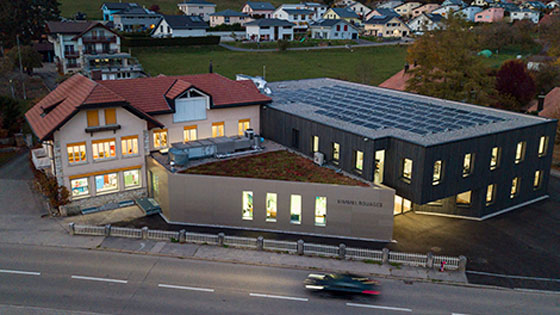
Active in the manufacture of watchmaking and microtechnical microcomponents, Gimmel Rouages inaugurated the extension of its Villiers site in the canton of Neuchâtel.
The floor space has been doubled (2,200 m2), greatly facilitating operations and making it possible not only to improve internal flows but also to increase production capacity. Through this expansion, the company is asserting its confidence in the future as well as its desire to develop, notably through the diversification of its activities.
The spacious, practical and bright new building, adjoining the existing site, respects the principles of sustainable development and building densification. Built on two levels, it uses Swiss wood for its envelope and is topped by 300sqm of photovoltaic solar panels. The extension did not require an increase in heating power since the heat from the compressors is now recovered. These environmental commitments are in line with the company’s values of sustainability and responsibility. The extension has also made it possible to create user-friendly spaces for staff.
Carried out by regional companies, the work took around ten months and involved an investment of several million francs. The architecture has also been carefully designed to restore a certain sense of aesthetic harmony to the site. The wood of the new building complements the materials previously used, such as the stone of the original building and the metal of the 2011 extension.
This inauguration is also a form of rebirth for Gimmel Rouages, since in June 2019, its workshops had been flooded due to the violent storms that ravaged the villages of Dombresson and Villiers. The company had had to make hasty temporary arrangements to continue operating, including during its expansion work. A year after the flooding, almost to the day, the move to the new premises began.
Founded in 1926, Gimmel Rouages – headed by David and Simon Guenin – manufactures mechanical watch movement components (wheels, arbors, pinions, wheel trains, etc.) mainly for high-end watch brands. It works in the realm of the infinitely small involving high added value. It also produces micromechanical components for other sectors, such as the machinery and equipment industry. It currently employs 68 people, most of whom come from the region, on its historical site in Villiers, which had already been extended several times (1968, 1998, 2011) to keep pace with production capacity.
December 10, 2020


 News
News